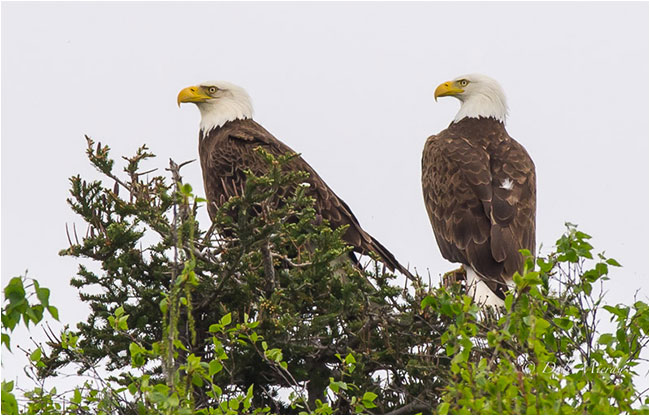
Some Adaptive Physical Characteristics of the Bald Eagle
By Dr. Dale Mierau
January 17, 2014
The bald eagle (Haliaeetus leucocephalus) is easily identified from afar by the flight pattern, the size and the plumage.
Bald eagles soar with a horizontal wing configuration to take advantage of updrafts and wind. Short, powerful wing beats are used sparingly because such activity uses a lot of energy in a bird this size. A bald eagle was observed to flap its wings for a total of only two minutes while soaring for an hour (Figure 0.5)
Figure 0.5
However, a bald eagle flies low over the water using a powerful, rapid wing cadence when it is carrying a fish or in the event of a perceived threat to the nest.(Figure 01)
Figure 01
The bald eagle is a large bird so high braking forces are needed to land with accuracy. (Figure 02)
Figure 02
Bald eagles exhibit reverse sexual dimorphism. The female is larger than the male. Other traits that distinguish a female from a male include the shape of the beak and the length of the hallux talon. The female beak resembles that of a parrot while the male sports a beak that is more hawk-like. (Figure 03)
Figure 03
The male has a shorter hallux talon (Figure 04) than a female (Figure 05).
Figure 04
The hallux talon is shorter for a male (Figure 04) than a female (Figure 05)
Figure 05
A young bald eagle grows at an alarming rate. Amber, the young female that I followed during the breeding season in 2013 was larger than her father when she was just 14 weeks old. (Figure 06)
Figure 06
The bald eagle has two eyelids. An outer opaque eyelid that closes during sleep and a semi-opaque inner eyelid called nictitating membrane. The nictating membrane ‘blinks’ by sliding laterally to protect the eye and keep it moist. The nictitating membrane becomes lighter in color with age. The membrane of this 10-week old bird is dark. (Figure 07)
Figure 07
The nictitating membrane of an adult bird is light colored and opalescent. (Figure 08)
The bald eagle has a specialized tongue with longitudinal ridges. The ridges serve to guide food down the throat. There is also an adjustable hole in the tongue. This vent lets in variable amounts of air to enhance calling and increase the entry of air to the lungs during flight. It also allows for increased airflow for temperature regulation during on a hot day. (Figure 09).
Figure 09
Bald eagles sometimes hunt while wading. An eagle can bring prey to the shore from deeper water by swimming using the wings as flippers. The eagle can also swim if it doesn’t make it to shore when carrying a fish that’s too heavy. This male was fishing in shallow water and got his head wet. He made every effort to dry off quickly by striking the same pose he would use to regulate body heat a hot day. (Figure 10)
Figure 10
The wet eagle in figure 10 is standing with his leg tucked underneath him like a stork. A locking mechanism in the bald eagle’s leg enables the foot to grip a branch, even when the bird is asleep. This adaptation is also used to grip and carry a fish. The male in Figure 11 had a two-pound Northern Pike in his grasp for at least 30 minutes.
Figure 11
My photographs of bald eagles are taken from a 21-foot open aluminum boat with a flat bottom. This boat is very stable and a good platform for photography. A boat of this type also provides a means of safe navigation across the often rough water on a large lake such as Lac LaRonge.
The camera is a Pentax K5 with a 300mm F4 prime lens. The Pentax camera and lens are water sealed and robust enough to withstand the often wet and rough boat ride.
I make every effort to use a shutter speed of 1/1500, faster for birds in motion. The K5 has five separate presets so I can set-up the camera even before I get into the boat. The presets ensure that I can at least start off with the ISO set at 400, a relative aperture of f/6.7 and an exposure value of +1. Another pre-set meant for stationary birds has a relative aperture of f/8 and an exposure value of +1.5. Conditions during the day always force changes to the camera settings but a quick push of a button will restore any preset I make.
Standing in the boat with the camera attached to a shoulder-mounted with both hands.
Figure 12
I observed a pair of bald eagles and their female hatchling during the spring, summer and fall of 2013 on Lac LaRonge, Saskatchewan. The goal of this project was to document the behavior of the family unit and chronicle the development of the youngster from a completely dependent hatchling a to an independent juvenile. I met the hatchling, that I named Amber, on June 13 when she was three weeks old. She was 20 weeks old when we parted ways on October 1. I hope to see her again in the spring of 2014.
|
Contact: Dr. Dale Mierau |
Also see Dr. Dale Mierau's previous article for Canadian Nature Photographer
Links to Additional Resources
1. Photographing Eagles on Lac LaRonge by Dr. Dale Mierau - December 11, 2011
2. Photographing Bald Eagles in Northern Saskatchewan by Dr. Dale Mierau - January 6, 2013
[ Top ]













